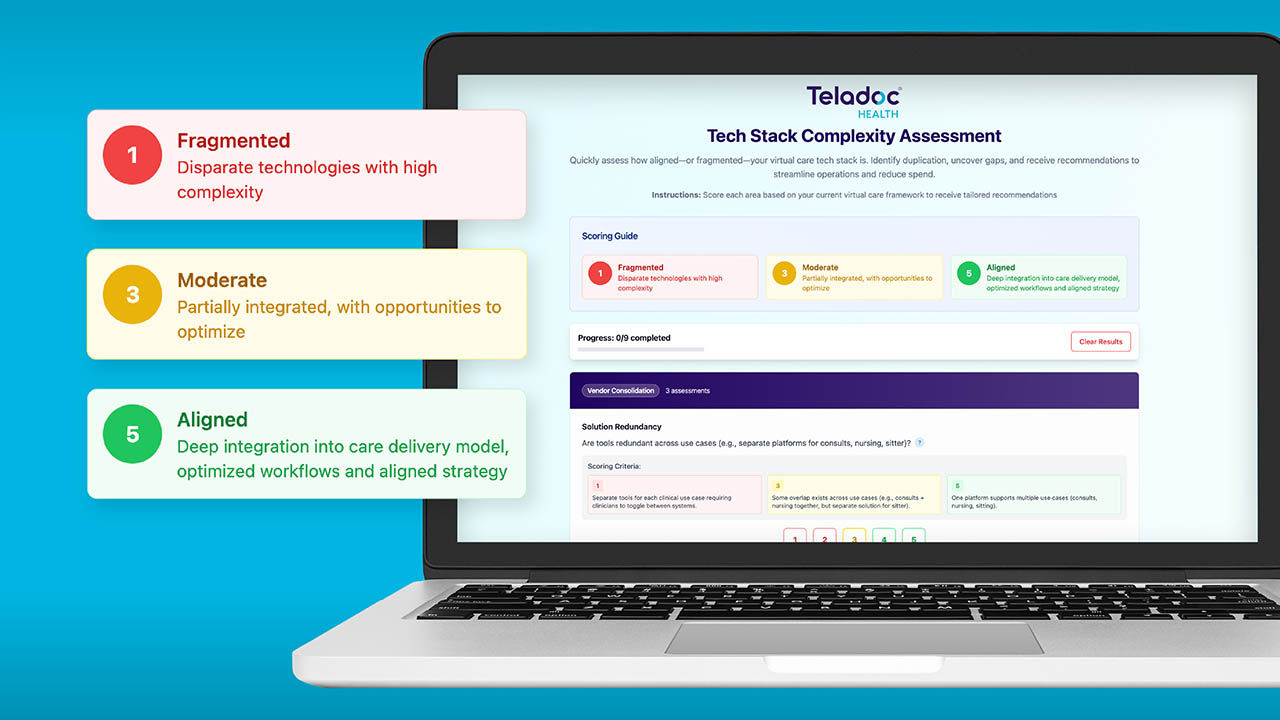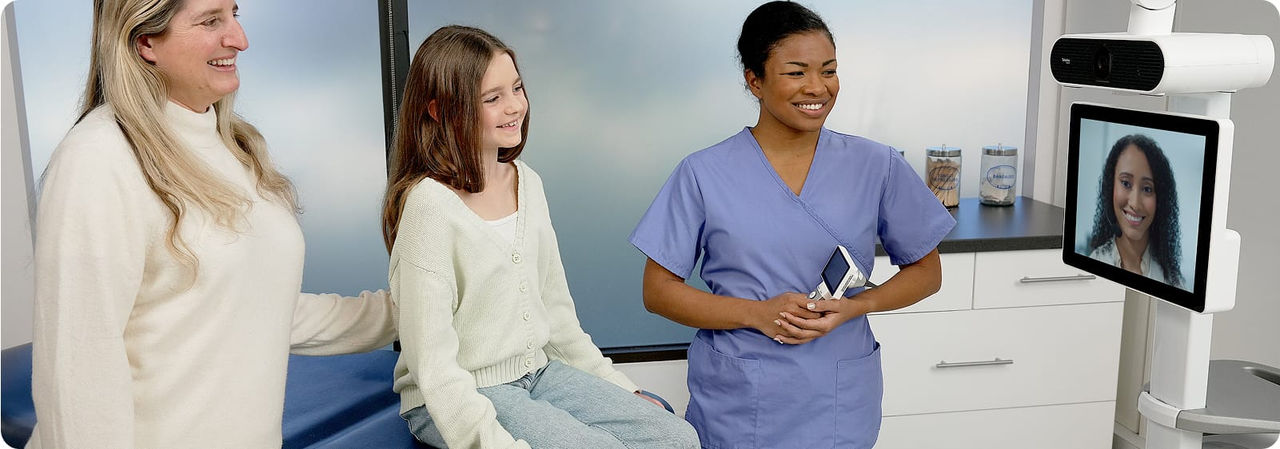CONNECTED CARE INSIGHTS
Access and affordability have been the primary barriers to providing timely, consistent and affordable care to rural patient populations. They still are, but providers must now address these challenges while assessing if and how to get involved in emerging care models and modalities, such as Accountable Care Organizations (ACOs), community-based partnerships, hub-and-spoke models, hospital-at-home programs and digital healthcare delivery options. By now, virtual care’s benefits and limitations for serving rural patient populations are well known. However, it is less known how virtual care can help rural providers succeed amid these changes by adapting new approaches and technologies that can deliver more types of care to more patients without a corresponding increase in staff.

Virtual care provides a platform for partnering
Many of the new care models being considered and adopted in rural health today involve some form of partnering. This includes partnering with other providers to meet the patient population requirement for Medicare Shared Savings Program (MSSB) ACO participation; partnering with schools, employers, retailers and other organizations to provide remote, community-based access to care; partnering with patients and their caregivers to enable more care at home; partnering with unions to allow virtual nursing, virtual sitting and other programs that can reduce patient-to-caregiver ratios; and partnering with other healthcare facilities in the region to create hub-and-spoke networks that expand specialty care by leveraging scarce resources. Here are some examples of how virtual care can enable or support these and other initiatives.
Create hub-and-spoke networks
Some rural health systems have created hub-and-spoke networks where specialists or other providers in one facility provide regular coverage to the others in the system virtually, without traveling from location to location. This coverage may involve direct interaction with patients or consultation with on-site providers to assist them in diagnosing conditions or performing procedures. One such arrangement resulted in nearly every South Carolina resident being within a 30-minute drive of expert neurology care.
24.2%
more likely to receive tPA than they were before telestroke services were available1
8%
less likely to die from a stroke1
10%
more likely to be released to home instead of a rehabilitation facility1
50%
faster door-to-needle time1
Pursue ACOs and value-based care
Hub-and-spoke networks can be a precursor to or component of MSSB ACOs, which require participants to have at least 5,000 Medicare fee-for-service beneficiaries. MSSP participation by rural health clinics, critical access hospitals and federally qualified health centers increased 16% in 2024, according to CMS.2 CMS data also suggest rural MSSP participants outperform others in savings.3
Mitigate skilled professional shortages
More than four out of five (82%) healthcare leaders say virtual care is helping them with staffing,4 including 46% who say it reduces on-site staffing requirements for certain roles and 56% who report it adds capacity to serve patients.5 Virtual care can also help reduce workplace stress by making it easier for medical staff to consult with specialists, receive mentorship or access support from colleagues. Smart cameras with AI analytics are helping to protect staff safety by detecting precursors to workplace violence and issuing proactive alerts.
Enable community partners
Programs can also be designed to overcome digital divides. Telehealth programs that are based in community centers or other public facilities, workplaces and schools make care available to people who don’t have computers or internet connections at home. One rural school-based program is credited with keeping an additional one to two students in school each week.6
Offer hospital-at-home options
Hospital-at-home programs are a way to expand access to care, and telehealth technology is the key enabler. One of the drawbacks to hospital-at-home care is the burdens it can place on patients and their caregivers, which telehealth can mitigate through emerging virtual nursing and virtual sitting, including emerging use cases for fall prevention and ambient listening.
When putting these ideas into practice, rural providers may have an important resource advantage over their urban and suburban counterparts: relatively high virtual care utilization and patient satisfaction levels. Despite persistent broadband gaps, rural residents now have higher telehealth utilization rates than urban/suburban ones,7 and they typically report positive patient experiences with virtual care.8 However, patient enthusiasm for virtual care comes with a risk: In 2024, approximately a quarter (24%) of all U.S. patients said they were willing to switch doctors to ensure access to virtual health options.9 That adds some urgency to continue to find ways to reach patients virtually.
Partnership and innovation are the common threads among the ideas and successes highlighted above. If you can find partners who share the belief that telehealth innovation can improve rural healthcare, then you’ll be on the path to success.
Take a deeper dive with these resources
1 Teladoc Health client success story, “Expanding telestroke access in rural communities.” – https://www.teladochealth.com/organizations/resources/expanding-telestroke-access-in-rural-communities
2 CMS Fact Sheet, January 15, 2025 – https://www.cms.gov/newsroom/fact-sheets/cms-moves-closer-accountable-care-goals-2025-aco-initiatives
3 CMS Performance Year 2024 Financial and Quality Results, September 29, 2025 – https://www.cms.gov/files/document/fact-sheet-ssp-py24-financial-quality-results.pdf
4 Philips Future Health Index 2024 – U.S. Report https://www.usa.philips.com/a-w/about/news/archive/standard/news/future-health-index/reports/2024/better-care-for-more-people.html
5 Philips Future Health Index 2024 – U.S. Report https://www.usa.philips.com/a-w/about/news/archive/standard/news/future-health-index/reports/2024/better-care-for-more-people.html
6 Teladoc Health, “Reviewing a school-based telehealth program.” – https://www.teladochealth.com/organizations/resources/reviewing-a-school-based-telehealth-program
7 Rowe Ferrara M, Chapman SA. Rural Patients' Experiences with Synchronous Video Telehealth in the United States: A Scoping Review. Telemed J E Health. 2024 May;30(5):1357-1377. doi: 10.1089/tmj.2023.0410. Epub 2024 Jan 24. PMID: 38265694.
8 Larson AE, Stange KC, Heintzman J, Zahnd WE, Davis MM, Harvey SM. Video versus audio telehealth in safety net clinic patients: Changes by rurality and time. J Rural Health. 2025 Mar;41(2):e12887. doi: 10.1111/jrh.12887. Epub 2024 Oct 2. PMID: 39358903; PMCID: PMC11952986.
9 Deloitte, “The growing disconnect between virtual health availability and patient demand,” October 16, 2024 – https://www2.deloitte.com/us/en/insights/industry/health-care/virtual-health-consumer-demand-and-availability.html










